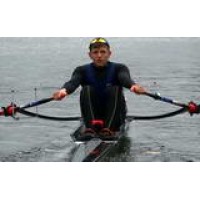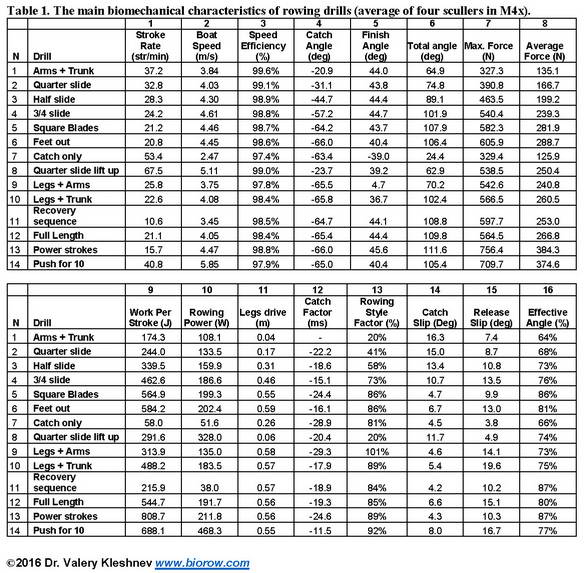Biomechanics of technical drills

Technical drills are widely used for teaching novices, and the perfecting of rowing technique. In RBN 2013/05 the drills were classified on their mechanics (static or dynamic drills), levels of detail (for separate elements or sequences), and mechanical conditions (standard or modified). The following 14 drills were identified as the standard sequence of a technical session and were performed 1 min each in M4x equipped with the BioRowTel measurement system:
1. “Arms + Trunk” is the first drill performed with the purpose of setting up the finish angles, minimising “washing out” and a clean, synchronised exit of the blade from the water.
2. “Quarter slide” – the purpose is to maintain an effective finish technique and add a short legs drive, working through the stretcher together in the crew.
3. “Half slide” – to increase the legs drive up to the transition point (knee angle 90o, RBN 2013/07), but not to pass it, so the rowers still do not need to switch between knee and hips expansions and can start the drive with the legs and trunk in simultaneous action, which makes coordination easier and the drive more solid and dynamic.
4. “3/4 slide” – even longer legs drive to pass the transition point and practise switching between knee and hips extensions. Shorter catch angle makes it easier to coordinate legs and trunk actions.
5. “Square Blades” – rowing at full length without feathering blades during recovery, which may help to improve the blade work at catch - finish, as well as balance.
6. “Feet out of shoes” rowing, where rowers cannot pull the stretcher at the finish. This drill emphasises a fast arms drive at the finish and “returning through the handle” (RBN 2006/10), which is the only effective technique.
7. “Catch only” is very short drive from the full length at catch to the transition point. The purpose is drilling the coordination of the legs drive and blade placement at catch with slightly earlier kicking the stretcher and achieving a negative Catch Factor (RBN 2015/09). Trunk angle must be constant during this drill and arms + shoulders stretched and under the tension.
8. “Quarter slide lift up” is similar to the drill 2, but with increasing of the stroke rate. Shorter catch angles create a lighter gearing ratio, which requires a fast, explosive activation of the trunk, especially at the higher rate. It is important to avoid “grabbing arms” in this drill.
9. “Legs + Arms”. Excluding the trunk action in this drill helps to develop fast legs drive, an optimal Rowing Style Factor (RBN 2015/10), and horizontal blade work.
10. “Legs + Trunk”. Excluding arm action helps to improve coordination of knee and hip extensions and actions of the most powerful muscle groups, which produce 80% of the rowing power, and also to avoid “grabbing arms” and it’s too early activation during the drive.
11. “Recovery sequence” (often called “Robot Rowing” or “sequencing”) is performed at low rate with three separate distinctive actions of “arms-body-slide” during the recovery with short stops between them, which improves body segment coordination. Timely trunk preparation (“pivoting around hips”) should be focused specifically, which help developing a proper sequence during the drive (“mirror principle”, RBN 2016/10-11).
12. “Full Length” rowing at a steady-state stroke rate is important part of technical training and helps to assemble all elements of the stroke cycle together, which were drilled separately before.
13. “Power strokes” is practising correct rowing technique at high force application. Suspension of the rower’s mass from the seat and “work through the stretcher” should be focused, which helps to develop a solid “connected” drive at maximal forces (at a low stroke rate).
14. “Push for 10 max rate” is practising correct rowing technique at high stroke rate (40+spm). It is important to maintain a sufficient stroke length (no more than 3-5 deg shorter than at low rate), a proper rowing style and blade work. In addition, it helps to develop a common sense of the rhythm and improve synchronisation in a crew (RBN 2015/03).
The main numerical characteristics of the above drills are given in the Table 1 of the Appendix. As the length of the stroke legs drive is getting longer in drills 1-4 and 12-13, the variation of the boat speed increases and its efficiency decreases from 99.6% down to 98.4%, which confirms findings of the previous Newsletter 2016/11. The boat acceleration curves (Fig.1) in the “slide progression” drills 1-4 confirms relationship between “the first peak” and passing of the transition point during the drive. Drills 1-2, without passing the transition point revealed a solid boat acceleration curve with one peak only (a). In drill 3, where the drive starts at the transition point, has shown a flat plateau (b). Passing the transition point in drill 4 caused the first peak (c) with following gap (d) and the second peak (e).





